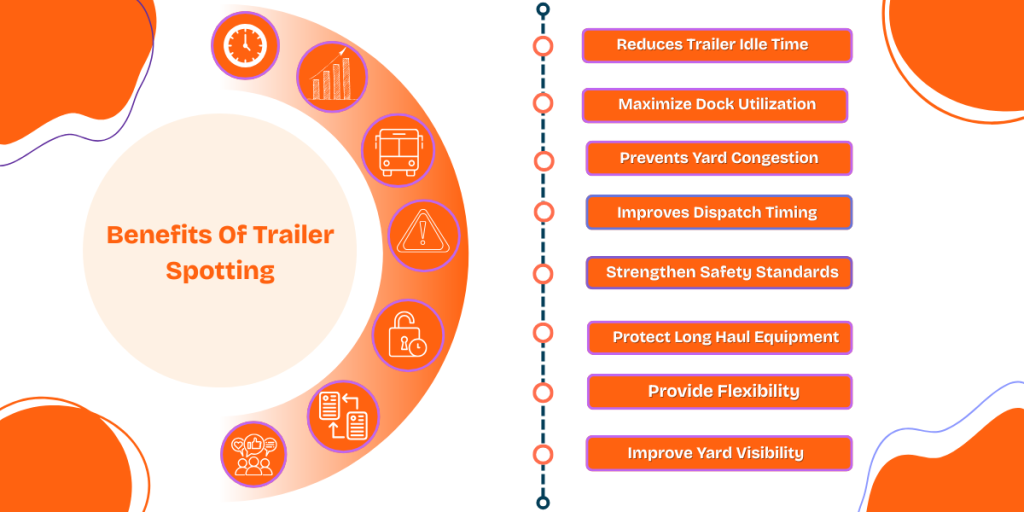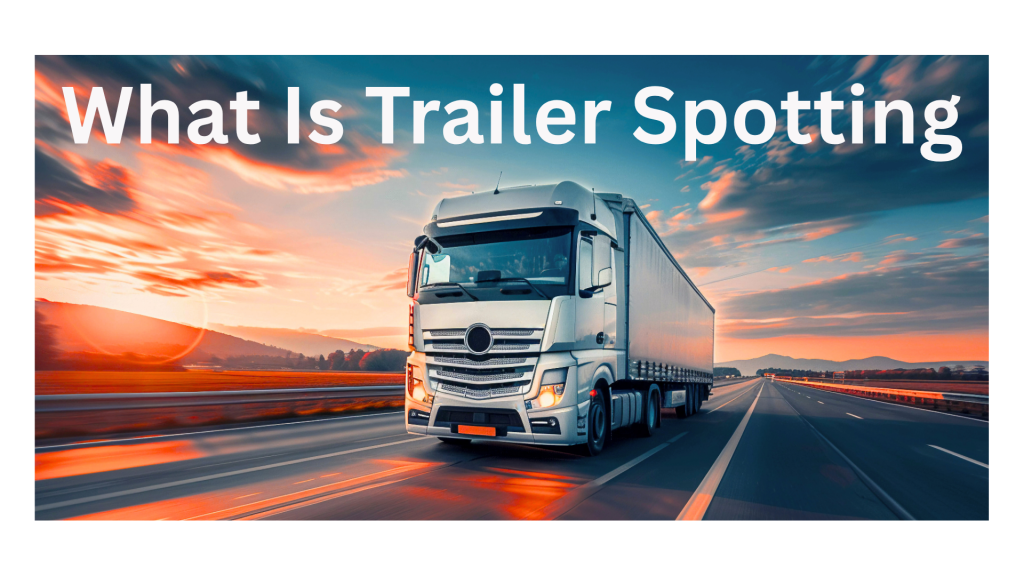If you have ever struggled to back a trailer into a narrow space, move it through a crowded yard, or find a secure spot to park overnight, you’re not alone. These challenges are part of daily life for truckers, fleet managers, and yard operators. And at the heart of solving all of them is one key practice, which is known as trailer spotting.
In this guide, we’ll walk you through what trailer spotting actually means, why it’s essential for efficient yard operations, and how it helps prevent costly delays. You’ll also learn practical tips for parking trailers in tight spots, how to move them safely when space is limited, and where to find trailer spots for rent near you.
Whether you are new to logistics or just looking to sharpen your yard game, this guide has you covered, from wheel to dock.
What Is Trailer Spotting?
Trailer spotting refers to the internal relocation of trailers within a freight yard or warehouse site using a designated yard truck, often referred to as a spotter or terminal tractor. The purpose of trailer spotting is to place trailers exactly where they’re needed, whether at a loading dock, staging lane, or outbound queue, without involving long-haul drivers. This division of responsibility helps avoid bottlenecks and maintains a consistent workflow inside the yard.
Spotting operations are often managed in real-time by logistics coordinators or yard management systems (YMS), ensuring each trailer is positioned in sequence based on its loading status, carrier pickup window, or dispatch priority.
Why Trailer Spotting Is Important For Optimizing Yard Operations
In high-volume logistics yards, poor trailer positioning slows down operations, blocked docks, delayed departures, and idle crews waiting for the next trailer. Trailer spotting prevents these disruptions by assigning trailer movement to dedicated yard trucks operated by trained personnel equipped to handle short-distance shifts quickly and accurately.
Trailer spotting also separates internal movement from transport schedules. While drivers focus on delivery routes, spotters maintain uninterrupted yard flow, keeping loading areas active and exit lanes clear. In operations where every minute counts, this separation of duties leads to higher throughput and fewer delays.
Facilities that use trailer spotting effectively minimize downtime, gain more control over trailer inventory, and operate with fewer disruptions, especially during peak load hours.
How To Back A Trailer Into A Parking Spot: Step-By-Step Guide
If you’re managing a yard, running a fleet, or driving a truck, you know one thing for sure, trailers don’t move themselves. And when space is tight, time is short, and docks are full, shifting trailers becomes a job in itself. Backing a trailer into a narrow space is one of the most challenging maneuvers in any yard. Limited visibility, pivot movement, and space constraints all make it difficult. But with the right technique, it can be done easily and efficiently without any damage.
Below are the key steps to back a trailer into a parking spot with control and confidence:

Step 1: Choose The Driver-Side Approach
Always try to back in from your driver’s side, this gives you a direct line of sight down the entire length of the trailer using your side mirror. When you back from the passenger side (blind side), your visibility is limited, which increases the risk of hitting something you can’t see. Backing from the driver’s side is not just easier, but also it’s safer and more accurate.
Step 2: Give Yourself Enough Space To Turn
Before you start reversing, pull forward just enough so your trailer has space to turn smoothly into the spot. The more space you give yourself at the start, the easier it will be to guide the trailer without making sharp turns. Don’t rush this step; setting up properly makes the rest of the process smoother.
Step 3: Check Your Surroundings
Before you start reversing, stop and take a full look around. Make sure there are no people, poles, trailers, or curbs in your path. Even experienced drivers use the get our and look (GOAL) rule, especially when visibility is limited or when parking between other trailers. It’s better to take 30 seconds to check than risk damaging equipment.
Step 4: Back Up Slowly And Control Your Steering
Backing up a trailer is not about power; it’s about precision. Start reversing at a slow, controlled speed. Keep your foot light on the brake and avoid sudden movements. Turn the wheel in the opposite direction you want the trailer to go. If you want the trailer to go left, turn the steering wheel to the right, and if you want to go in right direction then turn the steering wheel left. It might feel weird at first, but that’s just how trailers turn when you back up.
Step 5: Watch Your Mirrors Closely
Use both side mirrors to see how your trailer is lining up. Your driver-side mirror will give you the clearest view of the trailer’s path. The passenger-side mirror helps ensure you’re not getting too close to anything on that side. If the trailer starts to move in the wrong direction, just stop and fix it slowly.
Step 6: Line Up The Truck And Trailer With Dock
As the trailer starts to enter the parking spot, your goal is to get both the truck and trailer lined up with the dock. Start gently turning the steering wheel back the other way to bring the tractor into alignment with the trailer. This step is important to avoid ending up parked at an angle, which could block other units or make it difficult to pull out later.
Step 7: Park And Make Sure Everything Looks Right
Once your trailer is in the spot, stop the truck and set the parking brake. Get out of the truck and take a quick look. Ensure the trailer is positioned straight and not too close to anything. If it’s a little off, pull forward and fix it. It is better to fix that time than deal with it later.
How To Move A Trailer In A Tight Spot
Moving a trailer in a tight spot is more than just careful driving. It’s about reading the space, understanding your trailer’s swing, and knowing exactly when to stop, correct, and try again. If you’ve ever felt stuck or unsure in a cramped yard, this guide gives you the steps to move with confidence, without hitting anything or holding up the line behind you.
1. Check Before You Continue
Before doing anything, step out and check your surroundings. Walk the area and look for things like fences, poles, parked trailers, or tight turns. Know exactly where you’ll be going and what’s around you. This small step will provide you clear plan before moving.
2. Move Trailer Slowly
In tight spaces, going slow is safe. Move the trailer at a walking pace. When you go slow, you have time to react, correct small mistakes early, and avoid swinging too wide. Fast movement in tight areas usually leads to damage.
3. Watch The Rear
Your trailer’s back end is the most likely to hit something. Keep your eyes on how far it’s swinging as you move. Use your mirrors to track the trailer’s corners and make sure it’s not getting too close to anything on either side. Don’t just focus on the truck — the trailer matters more here.
4. Use Mirrors
Check both side mirrors often. One mirror won’t give you the full picture — what’s clear on one side might be tight on the other. Make it a habit to glance at both mirrors every few seconds while moving. It helps you stay centered and aware of your surroundings.
5. Ask Anyone For Guidance
If you have someone nearby, ask them to act as a spotter. A second set of eyes on the ground can guide you through blind spots or tight angles. Agree on clear hand signals or short instructions before you begin. Don’t assume anything on your own and communicate clearly with the spotter.
6. Fix The Position Of The Trailer
If your trailer starts turning too much or doesn’t feel lined up right, stop. Don’t try to push it into the spot. That’s when things usually go wrong. Instead, pull forward to straighten your truck and trailer, then back up again from a better position. It’s quicker to fix your angle now than to deal with damage later.
Benefits Of Using Trailer Spotting
Trailer spotting plays a crucial role in improving yard productivity, minimizing wait time, and keeping operations predictable. Below are distinct, practical benefits that directly support day-to-day logistics:

1-Reduces Trailer Idle Time: Spotters reposition trailers immediately after unloading or arrival, keeping docks and staging areas free for the next move
2-Maximizes Dock Utilization: Continuous trailer flow allows loaders and unloaders to work without interruption, increasing throughput per shift
3-Prevents Yard Congestion: Trailers are placed with intention, avoiding random parking or blocked lanes that slow down internal movement
4-Improves Dispatch Timing: Outbound trailers are pre-positioned and ready before scheduled pickup, reducing driver wait times and missed time slots
5-Strengthens Safety Standards: Professional spotters are trained to maneuver in tight areas, reducing the risk of trailer damage, collisions, or blocked emergency paths
6-Protects Long-Haul Equipment: Spotter trucks handle short-yard moves, minimizing wear on road tractors that aren’t built for constant coupling and tight turning
7-Provides Flexibility During Peak Hours: Spotting services scale with demand, maintaining yard flow even during seasonal spikes or multi-shift operations
8-Improves Yard Visibility and Control: Integrated with yard management systems (YMS), spotting operations allow better tracking of trailer locations and loading status
Final Thoughts
Keeping trailers in the right place at the right time isn’t always easy, but that’s exactly what trailer spotting helps you do. It brings structure to yard operations by making sure each trailer is placed exactly where it needs to be, without delays or confusion. For fleet owners, drivers, or yard managers, these small changes can lead to big improvements.
If your yard often feels crowded, unorganized, or behind schedule, it might be time to rethink how trailers are moved and positioned. Start by applying the tips in this guide. If you’are looking for trailer spotting services or nearby trailer spots to rent, explore your trailer spotting services options today and take back control of your yard.




